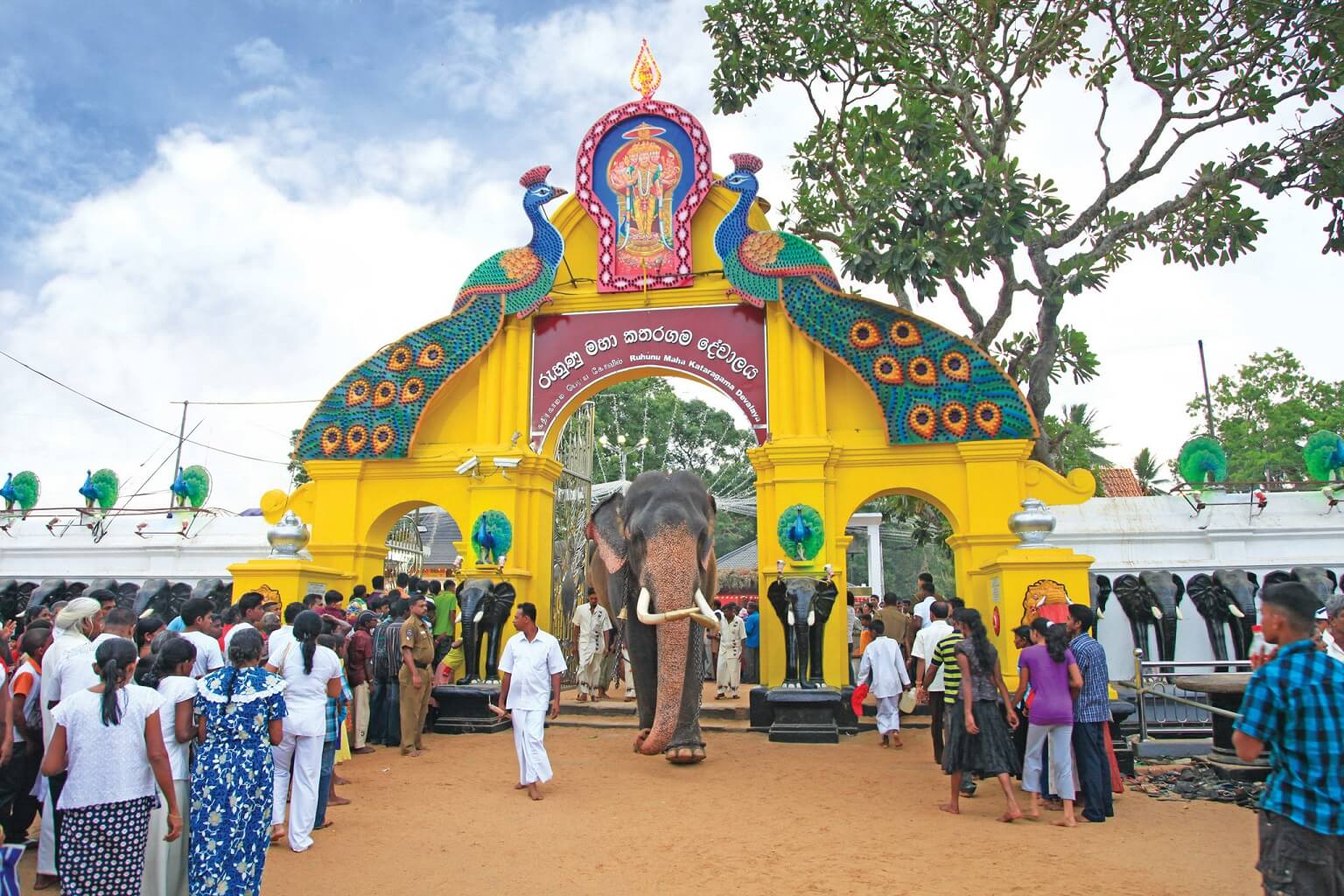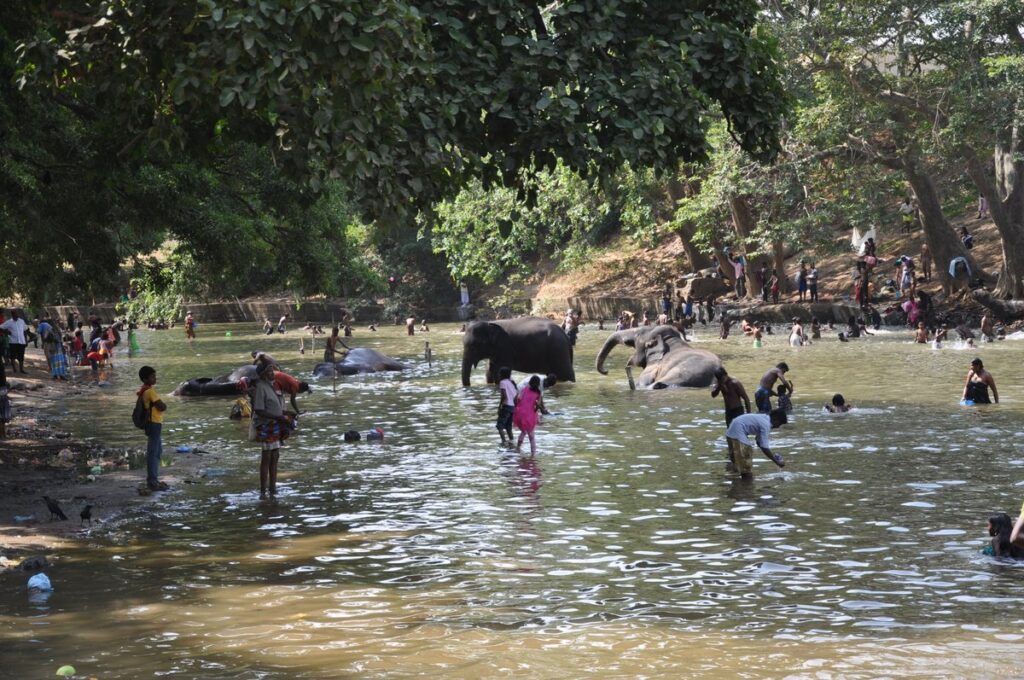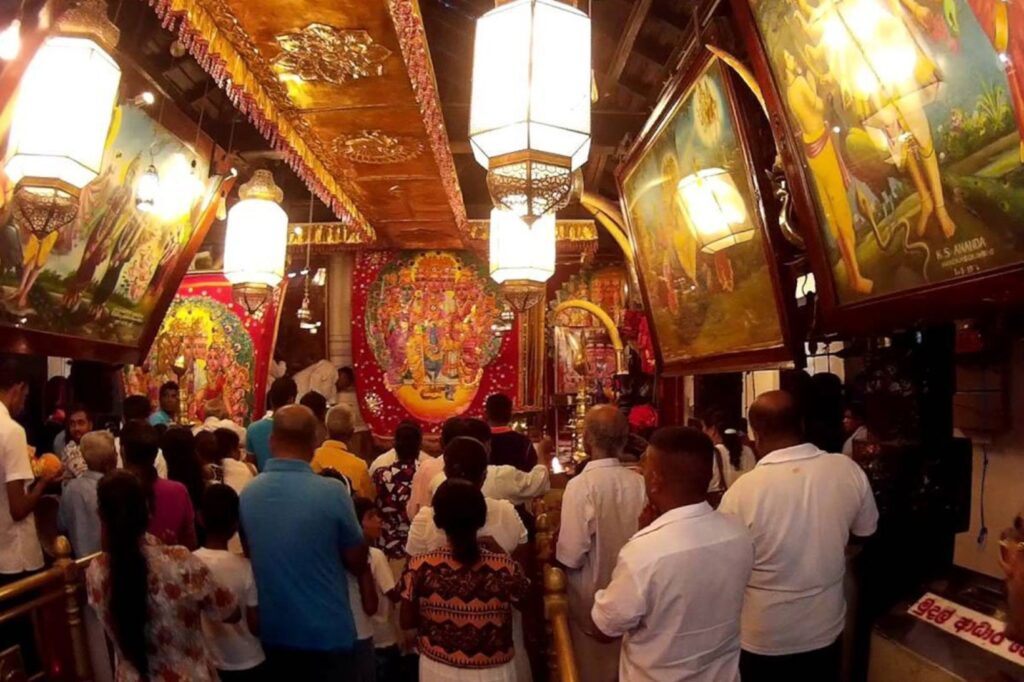
Kataragama is a very unique abode of Lord Karthikeya situated amidst luscious green forests by the banks of the cooling and sacred waters of the Manika Ganga. Specifically, in the Monaragala district of Uva Province in Southern Srilanka. The temple, officially known as Ruhuna Maha Kataragrama Devalaya stands below the Kathirmalai hill where Lord Karthikeya chose to reside.
Lord Karthikeya is known by different names such as Murugan, Subramaniam, Skanda, Kumara and Shanmugha to different people. The temple complex houses a Buddhist shrine and a mosque in front as well. Kataragama Deviyo is the Buddhist guardian deity of Srilanka worshipped at the Buddhist shrine.

Most of the rituals in the temple are done as per the Buddhist traditions due to the strong Buddhist influence that began here in the 1950s. Many rituals are derived from the Vedda tribe who reside nearby. During the 1950s, the Govt. of Srilanka declared Kataragrama as a holy place following which the temple became very popular.
The Government built very good infrastructure like an all-weather road, etc. to connect Kataragrama with the rest of Srilanka. The Hindus take care of the Tevayani temple and the Shiva temple nearby while the Buddhists take care of the remaining shrines excluding the mosque
Vedic History of Kataragama
The history of Kataragama has many versions like the Buddhist version, Vedda version, etc.
The place was earlier known as Kajjaragama (derived from the name ‘Karthikeya Grama’) in the work called as Mahavamsa written in the 5th century. This is said to be the first reference to Kataragama. The Ruhuna Kings had chosen Katargama as their capital city to shelter themselves from the invasions of the South Indian kings.
Sage Arunagirinathar, who has written extensively on the various abodes of Lord Karthikeya, had gone to Kataragama and confirmed its sacredness in the 15th century.
The Vedda tribe is believed to have started worshipping Lord Karthikeya here followed by the Hindus and Buddhists later. The local belief is that Lord Karthikeya arrived on the shores of Srilanka and then proceeded by walk to the Katirmalai hill beneath which the current shrine stands.
He had fought with his consort Thevayani and gone to Srilanka. He had settled on Katirmalai hill in Srilanka which was the abode of the Vedda tribe. During Lord Karthikeya’s stay on the hill, he came to hear about the adopted daughter of the Vedda chief called Valli.
Valli had desired to marry Lord Karthikeya after hearing about him from the people of her tribe. Lord Karthikeya understood Valli’s vow and hence, appeared in front of Valli as a handsome young hunter in a millet field to test her vow. Valli refused his proposal.
The next day, Lord Karthikeya appeared as an old brahmana in front of Valli asking if she could offer him something to eat. She offered him fruits and honey following which Karthikeya asked for water. While she was taking him to a well for drinking water, he asked her whether she felt afraid of staying alone when her tribal or family members went out hunting.
She replied that she was only afraid of elephants. Suddenly, Lord Ganesha appeared before her as an elephant. Valli clung onto Lord Karthikeya who was in the form of a brahmana. She begged him to save her life. He agreed on the condition that she should marry him. She agreed immediately following which the brahmana took her back to the village safely.
When Valli’s family saw them together, they rushed to attack Lord Karthikeya. But he turned into a tree instantly. When they attempted to cut down the tree, blood oozed out of the tree.
They slowly realized that the old brahmana and the tree were none other than Lord Karthikeya. Thereafter, Lord Karthikeya and Valli got married. The place where the Kataragama temple stands today is said to be the wedding spot of Lord Karthikeya and Valli.
Kataragrama in the Ramayana
As per the local folklores, Lord Karthikeya took an opportunity to serve Lord Ramachandra during the war with Ravana. This decision was taken when Indra got to know that Meghanath is going to use brahmastra against Lord Rama. Indra requested Karthikeya to participate in the war and neutralize the brahmastra.
When Meghanath shot the brahmastra, Karthikeya faced it and threw it in the ground finally neutralizing it at this place. Thus the place came to be known as Kataragama. Later Karthikeya chose to stay here attracted by the beauty of this place.
Deities of Kataragrama
Most of the Srilankan shrines have an influence of Buddhist philosophy in the rituals of worship. Therefore in this temple one is not allowed to have darshan of the Yantra. Only deemed pujaris are allowed to worship it. Instead one can have darshan of the curtain which has the insignia of Karthikeya seated on a peacock with His consorts. Same is found in the Vinayaka Temple, Shiva Temple, etc.
Lord Karthikeya is worshipped here in the form of a Yantra installed on a golden tablet. He is known here as Kathirkaman. Sage Kalyana Giri, the disciple of Bhogarnatha had installed the Yantra here after intense penances using the Skanda mantra for 12 years. He had performed penances at the location of the current sanctum.
The shrine of Valli lies outside the temple. There is a separate shrine for Tevayanai and Lord Shiva too.

Architecture of Kataragama
Simple architecture can be observed in the temple complex. Just a simple temple structure with earthen-tile roof.
The main gate and outer wall of the temple has carvings and sculpting. An arch-shaped gate with pillars on top followed by sculpting of peacocks and elephants look impressive. The outer wall is lined entirely with elephant and peacock sculpting.
Festivals of Kataragama
The festivals here are said to follow the Vedda traditions. The main festival here is known as Esela Perehera in Sinhalese. It is celebrated in the Tamil month of Adi i.e. between July and August.
45 days before the beginning of the festival, the priests go to the forest and get two forked branches of a sacred tree. They bring this to the temple and place them in the shrine of Lord Kathirkaman and Sri Valli.
When the festival begins, the Yantra which represents Lord Karthikeya is taken out on the top of an elephant to the shrine of Valli. After two hours, the Yantra goes back. On the last day, the Yantra is left overnight at the shrine of Valli and then goes back the next day.
Many devotees come all the way from different parts of Srilanka on foot covering the route in 45 to 57 days. They perform an exclusive dance called as Kavadi, fire walking and body piercing during this period.
Timings of Kataragama Temple
The temple timings are as follows –
Monday to Friday: 4.30 AM to 11 PM
Saturday & Sunday: 9.30 AM to 11.30 PM
How to Reach Kataragama
Visiting Kataragama is easier done than said with complete arrangements if you join the Srilanka Ramayana Yatra conducted by Tirtha Yatra.
Kataragama is located 256 kms away from Colombo, the national capital. The road and rail routes are the best options to reach Kataragama.
The following means of transportation could be very helpful –
By Road: Buses are available from Colombo Bastian Mawatha Bus Terminal to Kataragama 256 kms away. While buses are the cheapest mode of transport, they take the longest time to reach i.e. around six hours. Though costly, taxis will get you there in three hours.
By Rail: There is no direct rail line to Kataragama as of now. You can board a train from Colombo Fort Station to Beliatta. Further on, you can hire a taxi to reach Kataragama 86.4 kms away.
The new under-construction railway line promises to connect Kataragama directly via Hambantota.
By Air: The nearest airport is the Colombo Bandaranaike International Airport. You can fly in here and use the rail or road route to reach Kataragama.
1










Comment On Kataragama, Srilanka
G S
please could you let us know how we can book Abhishekam in advance? For those coming from abroad, please let us know how to pay for Poojas and Abhishekams in advance
Thank you